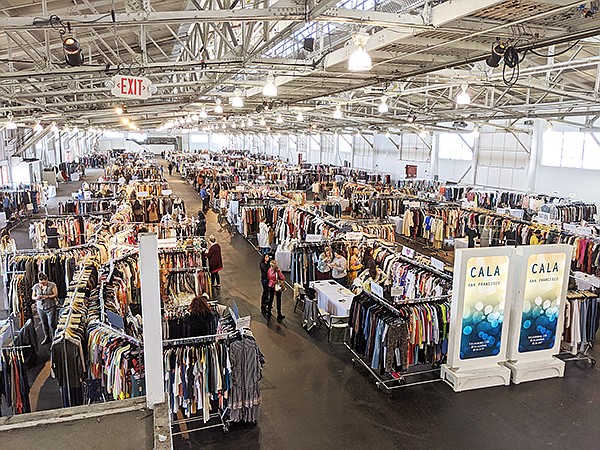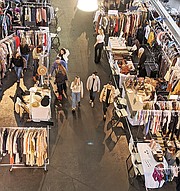TRADE SHOWS
CALA S.F. Delivers Amid Full Trade-Show Calendar
From its San Francisco home at the Fort Mason Center, the Bay Area edition of the CALA trade show enjoyed a strong showing from buyers and attendees during its Jan. 28–29 event. With other trade shows taking place from coast to coast across the United States during the same time, CALA San Francisco organizers were a bit uncertain about attendance at the show, but these concerns were quickly allayed.
“It was really, really good. I was worried about the other shows going on—there were so many. There were five other shows going on at the same time that some of our customers also attend. We were also worried about buyer attendance,” Robert Murtagh, a show organizer, said. “It was really good. Our customers are really happy.”
For this January show, CALA organizers remained committed to their customers and the attendees these exhibitors sought to attract. But even with a full trade-show calendar during this time of year, altering its plan wasn’t part of the CALA San Francisco mission.
“We kept the same formula,” Murtagh explained. “We didn’t want to try anything new this time with Vegas next week and the other competing shows.”
One area in which CALA saw a lot of growth was in the sustainable-clothing category, with buyers interested in exploring more options that are environmentally sound. Murtagh feels that this demand is proving to move beyond a trend as consumers search for goods whose manufacturing can be traced.
“They [buyers] are asking, ‘Where is sustainable? Point me in the direction of sustainable clothing.’ I noticed that in the last two shows. People are definitely becoming more eco-conscious, and we do have a section in our directory for the eco category, but I think we’ll change it to ‘Sustainable’ for the next show,” he said. “It seems—this year especially—people are talking about the environment.”
Consumers are willing to consider purchases of clothing manufactured through sources around the globe, but they are also considering how the garments are made. Shoppers remain price sensitive, but Murtagh mentioned that domestically manufactured goods are continuing to draw interest.
“Made in the U.S.A. and knowing what goes into the product is important to people these days,” he said.
One buyer committed to cultivating a luxury-clothing business is Kayci Stoots-Subia, owner of the Más Amor Salon in Sacramento, Calif. A salon owner for 17 years, Stoots-Subia has expanded her salon, located at the intersection of the city’s 23rd and Jay streets, to include a clothing boutique that she would like to eventually grow into a luxury-clothing destination independent of her beauty business.
“I decided to transition into a salon boutique with the hopes of opening a high-end boutique in Sacramento because we don’t have one,” she said. “It’s primarily small batch. It is a lot of women-owned companies. I want to keep everything ethical and slow fashion.”
The target consumers for Stoots-Subia are women ages 25 to 55. While she carries pieces for the men’s category, for the moment she is primarily focused on women’s accessories and clothing in sizes XS–L with wholesale price points ranging from $20 to $70.
While she has worked large events in the beauty industry and private parties that boasted guest lists of nearly 600 people, Stoots-Subia was impressed with the organization of CALA San Francisco, which was the first apparel-industry trade show that she has attended.
“To pull off something like that with so many moving parts, it was beautifully executed. It felt like it ran really smoothly,” she explained. “From lunch being served to coffee. Everyone’s stations were nice and kempt. Everyone was really nice, which was great.”
Another noticeable aspect of the show was the reception she received as a newcomer to the apparel business. Visiting booths by Free People, Little Work Project, Show Me Your Mumu and Daisy LA, Stoots-Subia reported that exhibitors were extremely accommodating and understanding.
“Especially being a first-timer, I didn’t know how people would receive me. I am a really small shop and don’t know what kind of numbers we’ll do,” she said. “The people from Little Work Project were very helpful. Also, the Show Me Your Mumu people were amazing and super helpful. I am so excited to go back.”
In addition to the willingness of exhibitors to help Stoots-Subia navigate this new business venture, another aspect of the show that she found impressive was all the vibrant trends. She saw matching sets, 1990s-inspired jewelry—with hoops still trending—bright colors and rich textures as she shopped for Immediates.
“Things are really bold right now. There are a lot of stripes and bright colors. There were bright, fun colors and a lot of texture,” she said. “There were several vendors that had really loud jackets, really amazing pieces. That was really cool. A lot gold jewelry, coin jewelry.”
Photos courtesy of CALA.
























